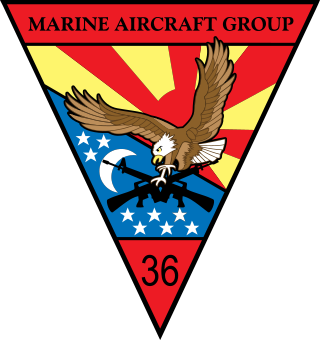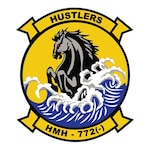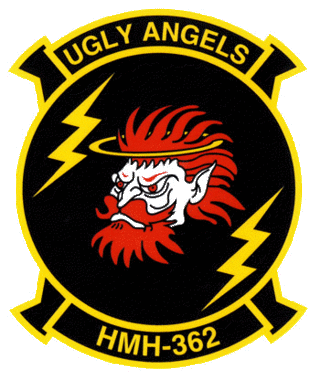
The Sikorsky CH-53E Super Stallion is a heavy lift helicopter operated by the United States military. As the Sikorsky S-80, it was developed from the CH-53 Sea Stallion, mainly by adding a third engine, adding a seventh blade to the main rotor, and canting the tail rotor 20°. It was built by Sikorsky Aircraft for the United States Marine Corps. Developed in the 1970s, it entered service in 1981, and is planned to be in service into the 2030s. It is one of the largest helicopters, and military helicopters in service, and is operated from U.S. Navy ships or from land.

Marine Helicopter Training Squadron 301 (HMT-301), was a United States Marine Corps helicopter training squadron stationed at Marine Corps Base Hawaii. Known as the Windwalkers, HMT-301 was part of Marine Aircraft Group 24 (MAG-24) and 1st Marine Aircraft Wing.

Marine Aircraft Group 36 (MAG-36) is an active air group of the United States Marine Corps, tasked with providing assault support aircraft. It is currently part of the 1st Marine Aircraft Wing, itself an integral part of the III Marine Expeditionary Force, and based at Marine Corps Air Station Futenma in Okinawa, Japan.

Marine Heavy Helicopter Squadron 772 (HMH-772) is a United States Marine Corps helicopter squadron consisting of CH-53E Super Stallion transport helicopters. The squadron, known as the Flying Armadillos with the Radio Callsign "Hustler", is based at McGuire AFB, New Jersey and falls under the command of Marine Aircraft Group 49 (MAG-49) and the 4th Marine Aircraft Wing.

Marine Heavy Helicopter Squadron 464 (HMH-464) is a United States Marine Corps helicopter squadron consisting of CH-53E Super Stallion transport helicopters. The squadron is known as the "Condors" and is based at Marine Corps Air Station New River in North Carolina. They fall under the command of Marine Aircraft Group 29 (MAG-29) and the 2nd Marine Aircraft Wing.

Marine Heavy Helicopter Squadron 361 (HMH-361) is a United States Marine Corps helicopter squadron consisting of CH-53E Super Stallion transport helicopters. The squadron, known as the "Flying Tigers", is based at Marine Corps Air Station Miramar in California, and falls under the command of Marine Aircraft Group 16 (MAG-16) and the 3rd Marine Aircraft Wing.

Marine Heavy Helicopter Squadron 462 (HMH-462) is a United States Marine Corps helicopter squadron operating CH-53E Super Stallion heavy transport helicopters. The squadron, known as the "Heavy Haulers", is based at Marine Corps Air Station Miramar in California and falls under the command of Marine Aircraft Group 16 (MAG-16) and the 3rd Marine Aircraft Wing.

Marine Aircraft Group 16 is a United States Marine Corps aviation unit based at Marine Corps Air Station Miramar that is currently composed of four V-22 Osprey squadrons, four CH-53 Super Stallion squadrons, one Personnel Support Detachment, and an aviation logistics squadron. The group falls under the command of the 3rd Marine Aircraft Wing and the I Marine Expeditionary Force.

Marine Heavy Helicopter Squadron 465 (HMH-465) is a United States Marine Corps helicopter squadron consisting of CH-53E Super Stallion transport helicopters. The squadron, known as "Warhorse", is based at Marine Corps Air Station Miramar in California and falls under the command of Marine Aircraft Group 16 (MAG-16) and the 3rd Marine Aircraft Wing.

Marine Medium Tiltrotor Squadron 362 (VMM-362) is a United States Marine Corps squadron that operates MV-22 Osprey. The squadron, known as the "Ugly Angels", was reactivated on 17 August 2018 at Marine Corps Air Station Miramar, California.

Marine Heavy Helicopter Squadron 461 (HMH-461) is a United States Marine Corps helicopter squadron consisting of CH-53K King Stallion transport helicopters. The squadron, known as "Ironhorse", is based at Marine Corps Air Station New River in North Carolina and falls under the command of Marine Aircraft Group 29 (MAG-29) and the 2nd Marine Aircraft Wing. With its lineage starting in 1944, HMH-461 is the oldest active Heavy Lift Helicopter Squadron in the Marine Corps.

Marine Heavy Helicopter Squadron 466 (HMH-466) is a United States Marine Corps helicopter squadron consisting of CH-53E Super Stallion transport helicopters. The squadron, known as the "Wolfpack", is based at Marine Corps Air Station Miramar, California and falls under the command of Marine Aircraft Group 16 (MAG-16) and the 3rd Marine Aircraft Wing.

Marine Heavy Helicopter Squadron 463 (HMH-463) was a United States Marine Corps helicopter squadron consisting of CH-53E Super Stallion transport helicopters. The squadron, also known as "Pegasus", was last based at Marine Corps Air Station Kaneohe Bay in Hawaii and fell under the command of Marine Aircraft Group 24 (MAG-24) and the 1st Marine Aircraft Wing. HMH-463 was decommissioned in April 2022 as part of the Commandant of the Marine Corps Force Design 2030 initiative.

Marine Aircraft Group 41 (MAG-41) is a United States Marine Corps reserve aviation unit based at Naval Air Station Joint Reserve Base Fort Worth, Texas that is currently composed of one F/A-18C squadron, one KC-130J squadron, one C-40 squadron, one Northrop F-5 aggressor squadron based at Marine Corps Air Station Yuma, Arizona, one Marine Light Attack Helicopter Squadron at MCAS Camp Pendleton, one MV-22B squadron based at MCAS Miramar, one aviation logistics squadron and two wing support squadrons with multiple detachments throughout the United States.

Marine Heavy Helicopter Training Squadron 302 (HMHT-302), is a United States Marine Corps helicopter training squadron stationed at Marine Corps Air Station New River, North Carolina. Known as the "Phoenix", HMHT-302 trains newly designated Naval Aviators, conversion pilots, refresher pilots, and enlisted aircrew on the CH-53E Super Stallion and falls under the command of Marine Aircraft Group 29 (MAG-29) and the 2nd Marine Aircraft Wing.

Marine Aircraft Group 49 is a United States Marine Corps Reserve aviation unit based at Joint Base McGuire–Dix–Lakehurst, New Jersey that is currently composed of squadrons that fly the MV-22B, CH-53E, AH-1Z, UH-1Y, UC-35D and UC-12F/W aircraft as well as an Aviation Logistics Squadron and Wing Support Squadron.

The United States Marine Corps Aviation (USMCA) is the aircraft arm of the United States Marine Corps. Aviation units within the Marine Corps are assigned to support the Marine Air-Ground Task Force, as the aviation combat element, by providing six functions: assault support, antiair warfare, close air support, electronic warfare, control of aircraft and missiles, and aerial reconnaissance. The Corps operates rotary-wing, tiltrotor, and fixed-wing aircraft mainly to provide transport and close air support to its ground forces. Other aircraft types are also used in a variety of support and special-purpose roles. All Marine Corps aviation falls under the influence of the Deputy Commandant for Aviation, whose job is to advise the Commandant of the Marine Corps in all matters relating to aviation, especially acquisition of new assets, conversions of current aircraft, maintenance, operation, and command.

Marine Heavy Helicopter Squadron 366 (HMH-366) was a United States Marine Corps helicopter squadron consisting of CH-53E Super Stallion heavy transport helicopters. The squadron, known as the "Hammerheads," was based at Marine Corps Air Station New River and fell under the command of Marine Aircraft Group 29 and the 2nd Marine Aircraft Wing. The squadron's tail code was "HH." At the squadron's reactivation on 30 September 2008, it had 130 Marines and 8 aircraft on-hand which grew to more than 300 Marines and 16 aircraft in 2009. The squadron was decommissioned on 16 December 2022 in accordance with Force Design 2030

Marine Light Attack Helicopter Squadron 467 (HMLA-467) was a United States Marine Corps helicopter squadron consisting of AH-1W SuperCobra attack helicopters and UH-1Y Venom utility helicopters. The squadron, nicknamed the "Sabers", was based at Marine Corps Air Station New River, North Carolina and was under the command of Marine Aircraft Group 29 (MAG-29) and the 2nd Marine Aircraft Wing. The squadron's aircraft markings are grey & white stripes on the aircraft tail to replicate the tail markings on a Diamondback Rattlesnake and the markings on the lighthouses in North Carolina.































